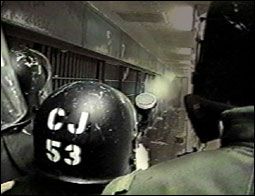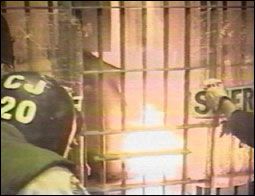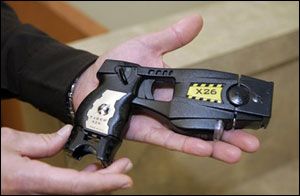Part 1 of 4
Read full series
In this series of articles I will discuss the use of less-lethal weapons in jails and prisons. This is a big topic, and one that is often misunderstood. There are myriad tools available to us and many more that are emerging. The last 12 to 13 years have seen an explosion of less-lethal options that, like a well placed flashbang, have left many with sensory overload.
Before addressing each specific tool and how to use it, there are some concepts and terms that need to be discussed. It is important that we all speak the same language on this subject so that we know what we mean.
 |
When you’re put on a witness stand, it is critical not only that you know how the less-lethal weapon you used works, but when to use it, how to describe that use and what your reason for using that tool was and not another.
How is the use of a less-lethal tool different from a lethal tool?
This question is not as self-evident as you might think. According to Commander Sid Heal’s “History of Less Lethal Weapons” presentation, “Lethal weapons attempt to defeat an adversary’s ability to resist while less-lethal devices attempt to defeat his will to resist.” An adversary’s ability to resist can be measured quantifiably, but his will cannot.
With the single exception of the TASER, all less-lethal tools primarily use pain compliance or the threat of pain to defeat an opponent’s will. Since everybody has a different tolerance for pain, there is not a formula that will tell us how much of any less-lethal tool we need to defeat an adversary. Steve Ijames recently addressed this problem in an article in Police1 (Read: When is enough enough? Reconciling the use of force “coercion/custody” dilemma.
Understanding that you are attempting to defeat your opponent’s will and not their ability by applying less lethals is critical. With all warfare, the goal is to win, not necessarily to fight. As Sun Tzu said, “For to win one hundred victories in one hundred battles is not the acme of skill. To subdue the enemy without fighting is the acme of skill.”
The implied threat of less-lethal weapons may end a fight before it begins. The actual use of these tools may cause him to quit or facilitate your ending the confrontation. That is defeating the will of your enemy.
What does the use of a less-lethal tool do for us?
 |
This question and the one before it are inextricably linked. I often hear that a less-lethal failed to work when it did not fail at all. What failed was the officer’s expectation of what that tool was designed to do.
Remember, we are attacking our opponent’s will to resist, not their ability to resist. The application of a less-lethal tool may lead to compliance by our adversary. But even if they comply, do we then just toss them the handcuffs and ask them to hook themselves up? There is always some follow on action required after the use of a less-lethal tool. This will vary based on the tool we are using and the circumstance of each situation, but it always exists.
What less-lethals are then are transitioning tools, they are not finishing techniques. Their intent is to modify the will of your opponent so that you can end his resistance. Whether that tool is a chemical, a kinetic or an electronic immobilization device, something must come next.
Penn State University’s Less Lethal Weapon’s Course refers to this as a “tactical break.” If an officer tries to spray, shoot or tase someone into submission, it means that they do not understand this concept. Some times the less lethal you are using might not be the right one, or the way you are using it needs to be changed. This will be addressed when each weapon system is discussed.
What is incapacitation?
This is another important concept that relates to the previous two. The Penn State Less Lethal Weapons course uses a definition from the military multi-service publication that is very helpful:
Incapacitation is achieved when a weapon’s effects render personnel unable to physically or mentally (real or perceived) act in a hostile or threatening manner. In keeping with the guiding principles for non-lethal weapons, this incapacitation should be readily reversible through the passage of time. The focus will be on the capabilities that affect both individuals and groups of people.
Again, just how you get to this point will vary from individual to individual. As many people have experienced, shining the light from a laser site on a subject can be a behavior modifier — this perceived threat can incapacitate.
The problem comes when we begin to count on perceived threats or forget that what can defeat the will of one adversary will not even phase another. Do not be lulled into a false sense of what less-lethal weapons will do for you by past successes or experiences in training.
What is a dose?
In medicine every prescribed medication has a recommended dosage and this term also applies to less-lethal weapons. Each application of a chemical, kinetic or any other less lethal can be referred to as a dose and as we will see recommended doses will defer from one weapons system to another.
How do we cover less-lethal weapons?
Here is where the application of less lethals in a custody environment differs from patrol. In the field, less-lethal weapons are always covered by lethal force. In corrections, less lethals are usually covered by other less lethals. This may vary in prisons, but it is almost always the case in jails. Do not rely on only one system for the reasons stated above. You may need to transition to a different tool to achieve your desired objective.
What do we mean when we say less-lethal weapons were deployed?
If you use the word deploy whenever you fire a less-lethal weapon, you are using the word incorrectly.
Dictionary.com defines deploy as, “to come into a position ready for use.” One of the definitions in Webster’s Dictionary says deploy means, “to station, or place, in accordance with a plan.”
There is no soldier or Marine who would ever confuse the word deployment with employment or use. Unfortunately, this is often the case in law enforcement and is codified in certain less-lethal weapons manufacturer’s lesson plans. No one would ever say that they deployed bullets from their gun. Why then do we say that we deployed OC or a TASER on an inmate?
What word should you use then?
Commander Sid Heal, of the Los Angeles Sheriff’s Department, says, “Use the word ‘employ’ when describing something being put into service and ‘deploy’ when something is placed into a position so that it can be used. You can deploy a TASER [or any other less lethal] without using it. You can also deploy a TASER without employing it, and vice versa.”
Deploying a less-lethal weapon means that you are routinely carrying it or are moving it from an armory into your jail or prison. When you actually use it on an inmate or inmates you are employing it. If this word doesn’t work for you try firing, activating, or any other term that is synonymous with use. According to Cmd. Heal, “Clarity is essential for understanding. When you are talking to a lay jury, you are in fact teaching them. Hence, common terminology and clarity become critical factors.”
Why is the use of proper terminology important? |
During the Los Angeles Riots in 1992 National Guard troops and Marines were routinely deployed with local law enforcement. Marines were assigned to work with deputy sheriffs and police officers in south Los Angeles County. There is one story that involved two Compton Police Officers and their Marine backup that has become a legend.
The two officers responded to a domestic violence call with the Marines in support. As the story goes, the officers asked the Marines to cover them before they approached the house. The officers then stepped out and approached the dwelling.
As soon as they did the Marines began riddling the house with their M16s. The facts of this encounter are slightly different: One of the officers in fact took shotgun pellets to the leg before the Marines opened up, but, they did open up. And the house was peppered with rounds to an extent well beyond the wildest dreams of any cop who has ever asked to be “covered” by a partner.
“Cover me” means something very different to soldiers and Marines than it does to cops. Fortunately, no one inside the house was injured, but it shows the importance of knowing the right terminology and using it properly. A misunderstanding and improper use of common terminology can not only lead to confusion, it can lead to tragedy.
Lawyers and many so-called law enforcement experts who testify against us know the proper terminology. Though some are book educated and could not lead ducks to water, others are former cops who have gone over to the dark side. They look very credible to judges and juries on the surface and they can beat us up by sounding more scientific about less lethal weapons and tactics than we do. Don’t let this happen to you, be more educated than they are.
Law enforcement tactics is more of a science than most cops think. We need to be as knowledgeable about the language and terms of our craft as any physician is about his.
